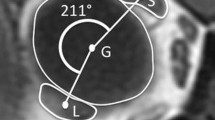Summary
In our Department of Orthoptics we have seen an increasing number of patients suffering from diplopia after cataract surgery with IOL implantation. Between 1993 and 1997 the total number of patients with this problem was 24 (2.7 % of all patients, mean age 71 years, age range 38–88). We addressed the question of whether there is a common pattern of motility dysfunction.
Methods: After evaluation of the clinical history and the basic ophthalmological findings the following parameters were examined: binocular function (Bagolini test), squint angles (Maddox cross), ocular motility.
Results: The 24 patients could be divided up into three groups. Group 1 consisted of 9 patients (mean age 82 years, range 64–88) who complained about diplopia because of strabismus incomitans with vertical deviation and restricted motility on the first day after surgery. In 8 of the 9 patients strabismus surgery was done. Group II consisted of 10 patients (mean age 66 years, range 38–77) who noticed diplopia and strabismus within 7 days after surgery. We found various kinds of heterotropia. Seven of these patients were operated on and two had a prism correction. Group III consisted of 5 patients (mean age 67 years, range 61–78). Their already known strabismus paralyticus or concomitans deteriorated, leading to diplopia in some cases. All patients in this group were operated on.
Discussion: For group I we believe that retro-, para- or peribulbar anesthesia caused the motility dysfunction. In groups II and III it is unlikely that local anesthesia had a causative role. The prolonged disruption of binocular vision and the abrupt change in the sensory situation after the cataract operation with lens implantation may be the leading causes for strabismus or deterioration of a preexisting strabism, respectively.
Conclusions: These patients need a subtil meticulous diagnostic work-up and follow-up because of the possibility of early surgical therapy, which has a good prognosis. Evaluation of binocular vision and eye movements prior to cataract surgery appears to be helpful for later strabismic surgery.
Zusammenfassung
Hintergrund: Die erwachsenen Patienten, die zwischen 1993 und 1997 wegen eines Strabismus untersucht wurden, waren zunehmend häufig mit Intraokularlinsen versorgt. Nach ein- oder beidseitiger Operation einer Cataracta senilis bzw. praesenilis mit Linsenimplantation war es zu einem Schielen, meist mit Doppelbildern gekommen.
Patienten und Methode: Untersucht wurden 24 Patienten von 38 bis 88 Jahren (Median 70,6 J.). Nach Analyse von Anamnese, Binokularfunktionen, Schielwinkel und Motilität wurden die verschiedenen Krankheitsbilder eingeordnet und mit differentialdiagnostischen Erwägungen über Pathogenese und Ätiologie verknüpft.
Ergebnisse: Es ließen sich 3 Gruppen bilden: In der 1. Gruppe hatten alle Patienten ab ersten postoperativen Tag Doppelbilder bei Strabismus incomitans mit Vertikaldeviation und restriktiver Motilitätsstörung. 8 von 9 Pat. wurden operativ korrigiert. Die 2. Gruppe bemerkte die Diplopie und den Strabismus in den ersten 7 postoperativen Tagen. Es fanden sich verschiedene konkomitierende Strabismusformen, die bei 7 der 10 Pat. operiert und bei zwei mit Prismen versorgt wurden. Die 3. Gruppe umfaßte Patienten, bei denen es zur Zunahme eines bekannten Strabismus concomitans bzw. paralyticus mit bzw. ohne Doppelbilder kam, welche bei allen 5 Pat. eine Operation erfordete.
Schlußfolgerung: Postoperative Diplopie nach Linsenimplantation bedarf einer sofortigen subtilen Diagnostik und Verlaufskontrolle, damit der Zeitpunkt einer adäquaten, meist chirurgischen Therapie, die eine gute Erfolgsquote aufweist, frühzeitig terminiert werden kann. Eine präoperative Erfassung des Binokular- und Motilitätsstatus würde die Beurteilung erleichtern.
Similar content being viewed by others
Author information
Authors and Affiliations
Rights and permissions
About this article
Cite this article
Schwarz, E., Gerdemann, M., Hoffmann, R. et al. Strabismus and diplopia as complications after cataract surgery with IOL implantation. Ophthalmologe 96, 635–639 (1999). https://doi.org/10.1007/s003470050465
Published:
Issue Date:
DOI: https://doi.org/10.1007/s003470050465




